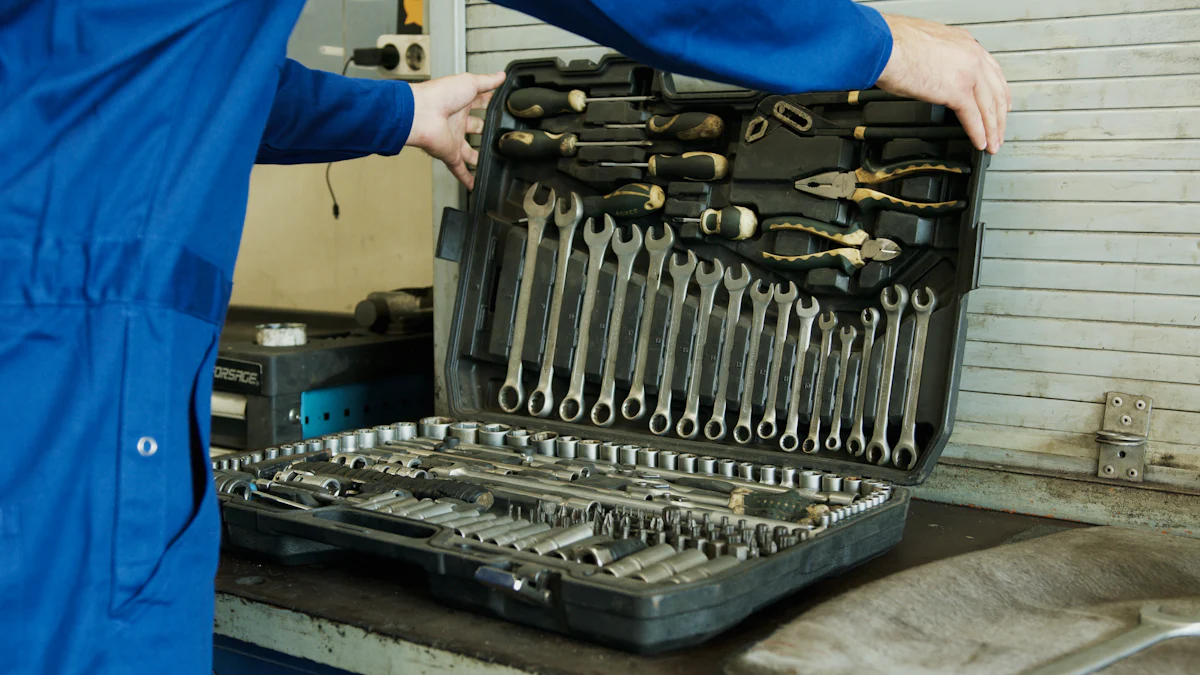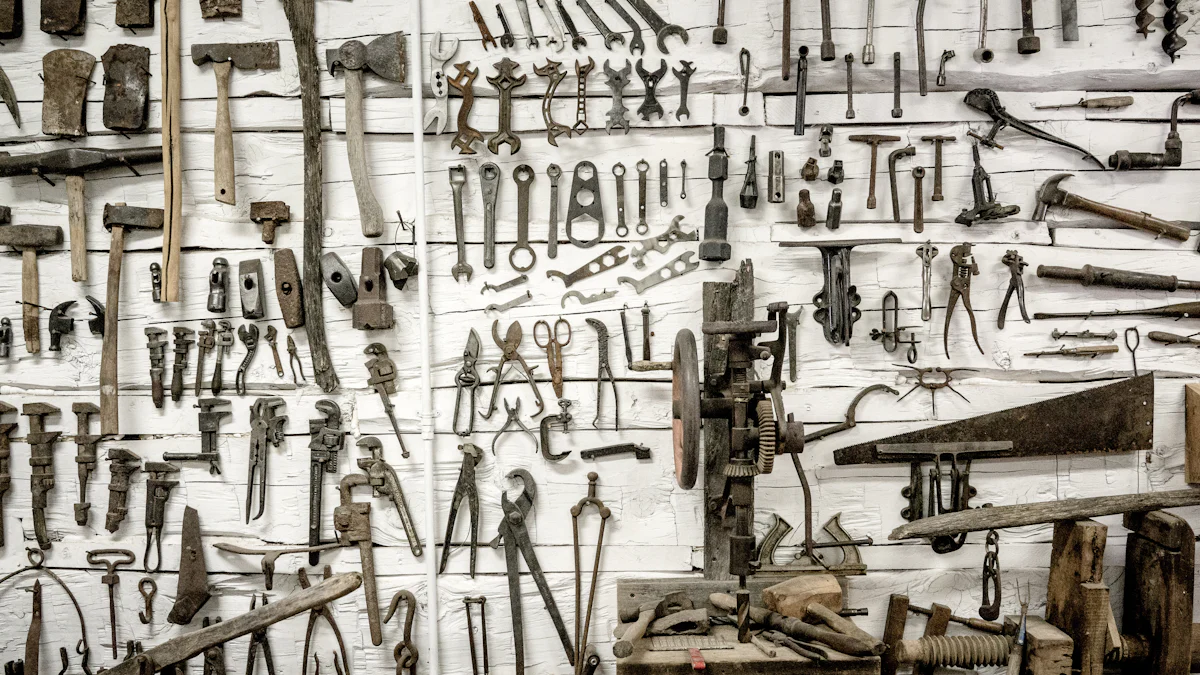
Hardware tools are physical objects used to manipulate, repair, or modify something. These tools play a crucial role in daily life by aiding in tasks such as home improvement and property maintenance. The variety of hardware tools available ranges from simple hand tools like hammers to advanced power tools like drills. The growth of the real estate market and the influence of DIY projects on social media have significantly increased the demand for these tools. Understanding how to define hardware tools helps in recognizing their importance and utility.
Define Hardware Tools
Definition of Hardware Tools
What Constitutes a Hardware Tool?
Hardware tools include physical objects used to manipulate, repair, or modify materials. These tools often consist of metals and plastics. Examples range from simple hand tools like hammers to advanced power tools like drills. The primary function involves aiding in various tasks, from home improvement to professional construction.
Historical Context
Ancient civilizations such as the Greeks, Romans, and Egyptians utilized early hand tools. These societies improved designs and materials over the Bronze and Iron Ages. Early humans used the lever principle during the Stone Age, leading to the evolution of cutting tools. Ancient cultures shaped stones and woods to create tools, addressing different needs. Blades for cutting purposes became sharper and more durable over time. Simple pliers also emerged as an ancient tool.
Importance of Hardware Tools
Everyday Use
Hardware tools play a vital role in daily life. Homeowners use these tools for tasks such as fixing leaks, hanging pictures, and assembling furniture. Gardeners rely on tools like shovels and pruners for maintaining gardens. DIY enthusiasts use various tools to complete personal projects.
Professional Use
Professionals in various industries depend on hardware tools. Carpenters use saws and hammers for constructing buildings. Electricians rely on screwdrivers and wire strippers for installing electrical systems. Mechanics use wrenches and sockets for repairing vehicles. Each profession requires specific tools to perform tasks efficiently and accurately.
Classification of Hardware Tools
Hand Tools
Definition and Examples
Hand tools offer versatility, precision, and control for various tasks. Users operate these tools manually, without the need for a power source. Common examples include hammers, screwdrivers, pliers, and wrenches. Each tool serves a specific purpose, from tightening screws to cutting or shaping materials.
Common Uses
Hand tools are essential for many everyday tasks. Homeowners use them for minor repairs, assembling furniture, and hanging pictures. Gardeners rely on hand tools like shovels and pruners for maintaining gardens. Professionals in trades such as carpentry and plumbing use hand tools for precise and controlled work. The manual operation of hand tools allows for greater accuracy in detailed tasks.
Power Tools
Definition and Examples
Power tools are devices powered by electricity, batteries, fuel, or compressed air. These tools perform tasks that require more force or precision than hand tools can provide. Examples include drills, saws, sanders, and grinders. Power tools can accomplish tasks more efficiently and accurately compared to manual methods.
Common Uses
Power tools are widely used in construction, woodworking, and metalworking. Carpenters use power saws for cutting wood quickly and accurately. Mechanics rely on power drills for assembling and disassembling parts. Electricians use power screwdrivers for installing electrical systems. Power tools save time and effort, making them indispensable in professional settings.
Measuring Tools
Definition and Examples
Measuring tools are instruments used to determine dimensions, distances, and angles. Accurate measurements are crucial for successful project completion. Common measuring tools include tape measures, calipers, levels, and protractors. These tools ensure precision in tasks ranging from home improvement to professional construction.
Common Uses
Measuring tools are vital in various fields. Builders use tape measures and levels to ensure structures are built to specifications. Machinists rely on calipers and micrometers for precise measurements of components. DIY enthusiasts use measuring tools for projects like installing shelves or laying flooring. Accurate measurements help prevent errors and improve the quality of work.
Types of Hardware Tools

Cutting Tools
Examples and Uses
Cutting tools are essential for achieving clean and accurate cuts in various materials like wood, metal, and plastic. These tools include saws, scissors, bolts, pipe cutters, and utility knives. Saws come in different types such as hand saws, circular saws, and jigsaws, each designed for specific cutting tasks. Scissors are versatile and used for cutting paper, fabric, and thin materials. Bolts and pipe cutters are specialized tools for cutting metal pipes and bolts to desired lengths. Utility knives are handy for cutting cardboard, plastic, and other lightweight materials.
Cutting tools play a crucial role in both professional and DIY projects. Carpenters use saws to cut wood for furniture and construction. Electricians rely on wire cutters to trim electrical wires. Plumbers use pipe cutters to fit pipes accurately. Homeowners find utility knives useful for opening packages and trimming materials during home improvement tasks. Cutting tools ensure precision and efficiency in various applications.
Fastening Tools
Examples and Uses
Fastening tools are crucial for joining or securing materials in various projects. These tools provide strength and stability, allowing secure connections between components. Common fastening tools include hammers, screwdrivers, wrenches, and pliers. Hammers drive nails into wood and other materials. Screwdrivers tighten or loosen screws in various applications. Wrenches grip and turn nuts and bolts. Pliers hold objects firmly and manipulate them as needed.
Fastening tools are indispensable in construction, automotive repair, and home maintenance. Carpenters use hammers and screwdrivers to assemble furniture and structures. Mechanics rely on wrenches and pliers for vehicle repairs. Homeowners use fastening tools for tasks like hanging pictures, assembling furniture, and fixing loose screws. Fastening tools ensure secure and stable connections in various projects.
Shaping Tools
Examples and Uses
Shaping tools are designed to modify the form or surface of materials. These tools include files, rasps, chisels, and sanders. Files and rasps smooth and shape metal, wood, and plastic surfaces. Chisels carve and cut wood, creating intricate designs and shapes. Sanders smooth surfaces by removing small amounts of material, providing a polished finish.
Shaping tools are essential in woodworking, metalworking, and crafting. Woodworkers use chisels and sanders to create detailed furniture and decorative items. Metalworkers rely on files and rasps to refine metal parts and components. DIY enthusiasts use shaping tools for personal projects like creating sculptures or custom pieces. Shaping tools enable precise and detailed modifications to various materials.
Components of Hardware Tools
Materials Used
Metals
Metals form the backbone of many hardware tools. Steel, aluminum, and iron are common choices. Steel offers strength and durability. Aluminum provides a lightweight option. Iron ensures robustness for heavy-duty tasks. Each metal type serves specific purposes in tool manufacturing.
Plastics
Plastics also play a crucial role in hardware tools. High-density polyethylene (HDPE) and polyvinyl chloride (PVC) are popular choices. HDPE offers flexibility and impact resistance. PVC provides chemical resistance and durability. Plastics often complement metals to enhance tool functionality.
Design Features
Ergonomics
Ergonomics focuses on user comfort and efficiency. Tools with ergonomic designs reduce strain and fatigue. Handles with soft grips improve control. Balanced weight distribution enhances usability. Ergonomic features make tools more user-friendly.
Durability
Durability ensures long-lasting performance. High-quality materials resist wear and tear. Protective coatings prevent rust and corrosion. Reinforced joints and connections add strength. Durable tools withstand rigorous use over time.
Practical Applications of Hardware Tools

Home Improvement
Common Projects
Home improvement projects often require a variety of hardware tools. Basic tasks like hanging pictures or assembling furniture need simple hand tools. Hammers and screwdrivers are essential for these activities. More complex projects, such as building a deck or renovating a room, demand advanced tools. Power drills and saws become necessary for cutting and fastening materials efficiently.
Garden maintenance also falls under home improvement. Gardeners use shovels and pruners to maintain plants and landscapes. Lawn mowers and hedge trimmers help keep outdoor spaces tidy. These tools make gardening tasks quicker and more manageable.
DIY enthusiasts frequently undertake creative projects. Building custom furniture or crafting decorative items requires precision tools. Sanders and chisels help achieve smooth finishes and intricate designs. Quality hardware tools ensure successful completion of these projects.
Professional Use
Industries and Trades
Various industries rely heavily on hardware tools. Construction workers use a wide range of tools daily. Saws and drills assist in building structures. Measuring tools like tape measures ensure accuracy in dimensions. Quality tools enhance efficiency and safety on construction sites.
Mechanics depend on specific tools for vehicle repairs. Wrenches and sockets allow for the disassembly of engine parts. Power tools like impact drivers speed up the repair process. Accurate tools ensure proper vehicle maintenance and performance.
Electricians require specialized tools for their trade. Wire strippers and voltage testers are essential for installing electrical systems. Screwdrivers and pliers help in securing connections. Reliable tools ensure safe and efficient electrical work.
Plumbers also benefit from quality hardware tools. Pipe cutters and wrenches are crucial for fitting pipes. Plumbers use these tools to ensure leak-free installations. Durable tools withstand the demands of plumbing tasks.
Investing in high-quality hardware tools offers long-term benefits. Quality tools provide better performance and durability. These tools reduce the need for frequent replacements. The initial cost may be higher, but the long-term savings outweigh this expense.
Benefits of Using Hardware Tools
Efficiency
Time-Saving
Hardware tools significantly enhance efficiency in various tasks. Power tools like drills, saws, and routers complete jobs faster than hand tools. Equipped with motors, power tools offer more power and benefits compared to manual tools. This increased power allows for quicker completion of complex projects.
Technological advancements have revolutionized construction processes. Modern tools enable faster completion times and improved project outcomes. For example, a power drill can drive screws in seconds, reducing the time spent on manual screwing. Efficient tools save valuable time, allowing workers to focus on other important tasks.
Precision
Accuracy in Tasks
Precision is crucial in many tasks, and hardware tools provide the necessary accuracy. Power tools improve efficiency and precision, making them invaluable for intricate work. Tools like laser levels and digital calipers offer exact measurements, ensuring high-quality results.
Accurate tools prevent errors that could lead to costly rework. For instance, a digital caliper measures components with high precision, reducing the risk of incorrect fits. High-quality hardware ensures secure installations and reliable performance. This reliability contributes to the overall effectiveness of the final product.
Power equipment allows for more accurate measurements and better project outcomes. Builders use laser levels to ensure structures are perfectly aligned. Carpenters rely on precise saws to make clean cuts. Accurate tools enhance the quality of work, leading to professional and polished results.
Comparisons of Hardware Tools
Hand Tools vs. Power Tools
Pros and Cons
Hand tools and power tools each offer unique advantages and disadvantages. Understanding these differences helps users choose the right tool for specific tasks.
Pros of Hand Tools:
- Control: Hand tools provide greater control over precision tasks.
- Safety: Hand tools pose fewer risks compared to power tools.
- Durability: Hand tools tend to last longer due to fewer moving parts.
- Simplicity: Hand tools require no power source, making them easy to use.
Cons of Hand Tools:
- Speed: Hand tools are slower, requiring more time to complete tasks.
- Effort: Hand tools demand more physical effort from the user.
- Versatility: Hand tools may not handle complex tasks as efficiently.
Pros of Power Tools:
- Speed: Power tools complete tasks much faster.
- Power: Power tools offer more force, ideal for heavy-duty tasks.
- Precision: Power tools provide increased accuracy and consistency.
- Efficiency: Power tools reduce physical strain on the user.
Cons of Power Tools:
- Cost: Power tools are generally more expensive.
- Safety: Power tools can be dangerous if not used properly.
- Maintenance: Power tools require regular maintenance and repairs.
- Dependency: Power tools rely on electricity or batteries, limiting their use in some situations.
Traditional vs. Modern Tools
Technological Advancements
Technological advancements have significantly impacted hardware tools, leading to the development of modern tools that offer enhanced features and capabilities.
Traditional Tools:
- Materials: Traditional tools often use basic materials like wood and iron.
- Design: Traditional tools feature simple designs with manual operation.
- Durability: Traditional tools are known for their robustness and longevity.
- Usage: Traditional tools require more skill and experience to operate effectively.
Modern Tools:
- Materials: Modern tools incorporate advanced materials like high-strength alloys and composites.
- Design: Modern tools feature ergonomic designs for improved user comfort.
- Technology: Modern tools integrate technology for enhanced performance, such as laser guides and digital displays.
- Efficiency: Modern tools offer greater efficiency and precision, reducing the time and effort needed for tasks.
Key Technological Advancements:
- Laser Guides: Laser guides help ensure accurate cuts and measurements.
- Digital Displays: Digital displays provide precise readings for measurements and settings.
- Battery Technology: Improved battery technology extends the runtime of cordless power tools.
- Smart Tools: Smart tools connect to apps for enhanced functionality and monitoring.
Understanding these comparisons helps users make informed decisions when selecting hardware tools for various projects.
Hardware tools hold immense importance and variety. These tools range from simple hand tools to advanced power tools. Exploring different types of hardware tools can enhance efficiency and precision in various tasks. Utilizing the right tools can transform home improvement projects and professional work. Hardware tools significantly impact daily life and various industries. Investing in quality tools ensures better performance and durability. The right tools make tasks more manageable and rewarding, encouraging continuous exploration and utilization.
See Also
Scooter Upgrades: High-Quality Parts for Optimal Performance
Discovering a Range of Men’s and Women’s Sock Options
